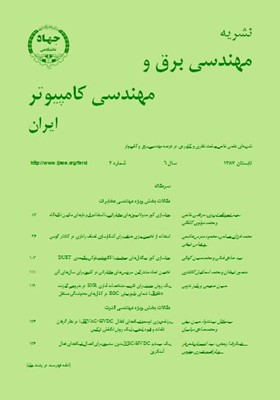جداسازی کور مدولاسیونهای مخابراتی با استفاده از بردارهای ماشین تکیهگاه
محورهای موضوعی : مهندسی برق و کامپیوترسعید شعرباف تبریزی 1 , مرتضی خادمی 2 , محمد مولوی کاخکی 3
1 - دانشگاه فردوسی مشهد
2 - دانشگاه فردوسی مشهد
3 - دانشگاه فردوسی مشهد
کلید واژه: الگوريتم ژنتيکبردار ماشین تکیهگاهتشخيص مدولاسيونتشخيص الگو,
چکیده مقاله :
در اين مقاله سيستمی برای تشخيص نوع مدولاسيون پيشنهاد ميشود که قادر است بدون شناخت اولیه از پارامترهای سیگنال ارسالی، 9 مدولاسیون از خانواده مدولاسيونهاي فاز، دامنه و فاز- دامنه را شناسايي کند. برای تشخيص، طبقهبنديکننده SVM پیشنهاد شده است. پيچيدگي محاسباتي کم، سرعت آموزش بالا و درصد تشخيص بالاتر نسبت به ساير روشهای تشخیص مدولاسیون مانند سطوح آستانه ثابت و متغیر و شبکههای عصبی، از مزاياي روش پیشنهادی به شمار ميآيند. نتایج شبیهسازی نشان میدهد که استفاده از ساختارهای سلسله مراتبی از طبقهبندیکننده SVM نیز میتواند به بهبود عملکرد بیانجامد. در این مقاله، استفاده از الگوریتم ژنتیک در بهینهسازی ساختار طبقهبندیکننده و نیز انتخاب بهینه ویژگیهای مورد استفاده در ساختار سلسله مراتبی، سبب افزایش قابل ملاحظه دقت تشخیص مدولاسیونها گردیده است.
Automatic modulation type classifier is a system which recognizes the modulation type of received signal automatically from some possible, pre-assumed types. Automatic modulation classification has applications such as spectrum surveillance, signal confirmation, interference identification, software radio, etc. This paper, proposes a new method for recognition of 9 famous digital and analog modulations, which no need for prior knowledge of the signal to be recognized. This system is used to separate AM, FM, DSB and SSB in Analog modulations and 2ASK, 2PSK, 2FSK, 4PAM and 16QAM in digital modulations. Support Vector Machines (SVM) is used to classify these modulations and Genetic Algorithm is used to optimize Classifier Structure. Simulation results show that proposed algorithms have a good performance in comparison with other algorithms. Computational simplicity, High training speed and High classification rate, are the advantages of proposed algorithms.
[1] Y. Yang and S. S. Soliman, "A suboptimal algorithm for modulation classification," IEEE Trans. on Aerospace and Electronic Systems, vol. 33, no. 1, pp. 38-45, Jan. 1997.
[2] W. Wei and M. Mendel, "A new maximum - likelihood for modulation classification," in Proc. IEEE Int. Conf. onCommunications, vol. 1, pp. 57-61, Feb. 1996.
[3] E. Azzouz and A. Nandi, "Algorithms for automatic modulation recognition of communication signals," IEEE Trans. on Commun., vol. 46, no. 4, pp. 431-436, Jan. 1998.
[4] A. Iversen, Classification of Digital Modulation Schemes Using Multi - Layered Perceptrons, Ph.D Thesis, Heriot Watt University, pp. 30-35, Feb. 2004.
[5] Q. Cai and P. Wei, "A digital modulation recognition method," in Proc. IEEE Int. Conf. on Communications, vol. 3, pp. 863-866, Apr. 2004.
[6] F. Bo, C. Jun, and C. Gnag, "An algorithm of SNR estimation for non constant envelope signal in the AWGN channel," Acta Electronica Sinica, vol. 30, no. 1, pp. 1369-1371, Apr. 2002.
[7] H. Stark and J. W. Woods, Probability, Random Processes, and Estimation Theory for Engineers, 2nd ed., Prentice - Hall, 1994.
[8] C. J. C. Burges, "A tutorial on support vector machines for pattern recognition," Data Mining and Knowledge Discovery, vol. 2, no. 1, pp. 955-974, Apr. 1998.


